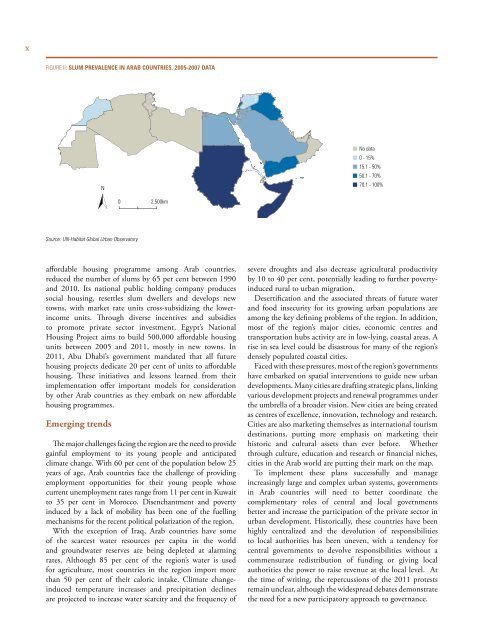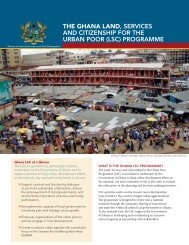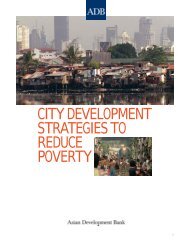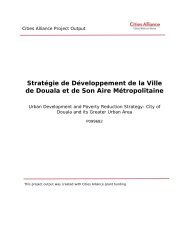Arab Cities2012 - Cities Alliance
Arab Cities2012 - Cities Alliance
Arab Cities2012 - Cities Alliance
Create successful ePaper yourself
Turn your PDF publications into a flip-book with our unique Google optimized e-Paper software.
x<br />
FIGURE II: SLUM PREVALENCE IN ARAB COUNTRIES, 2005-2007 DATA<br />
Source: UN-Habitat Global Urban Observatory.<br />
N<br />
affordable housing programme among <strong>Arab</strong> countries,<br />
reduced the number of slums by 65 per cent between 1990<br />
and 2010. Its national public holding company produces<br />
social housing, resettles slum dwellers and develops new<br />
towns, with market rate units cross-subsidizing the lowerincome<br />
units. Through diverse incentives and subsidies<br />
to promote private sector investment, Egypt’s National<br />
Housing Project aims to build 500,000 affordable housing<br />
units between 2005 and 2011, mostly in new towns. In<br />
2011, Abu Dhabi’s government mandated that all future<br />
housing projects dedicate 20 per cent of units to affordable<br />
housing. These initiatives and lessons learned from their<br />
implementation offer important models for consideration<br />
by other <strong>Arab</strong> countries as they embark on new affordable<br />
housing programmes.<br />
Emerging trends<br />
0 2,500km<br />
The major challenges facing the region are the need to provide<br />
gainful employment to its young people and anticipated<br />
climate change. With 60 per cent of the population below 25<br />
years of age, <strong>Arab</strong> countries face the challenge of providing<br />
employment opportunities for their young people whose<br />
current unemployment rates range from 11 per cent in Kuwait<br />
to 35 per cent in Morocco. Disenchantment and poverty<br />
induced by a lack of mobility has been one of the fuelling<br />
mechanisms for the recent political polarization of the region.<br />
With the exception of Iraq, <strong>Arab</strong> countries have some<br />
of the scarcest water resources per capita in the world<br />
and groundwater reserves are being depleted at alarming<br />
rates. Although 85 per cent of the region’s water is used<br />
for agriculture, most countries in the region import more<br />
than 50 per cent of their caloric intake. Climate changeinduced<br />
temperature increases and precipitation declines<br />
are projected to increase water scarcity and the frequency of<br />
No data<br />
0 - 15%<br />
15.1 - 50%<br />
50.1 - 70%<br />
70.1 - 100%<br />
severe droughts and also decrease agricultural productivity<br />
by 10 to 40 per cent, potentially leading to further povertyinduced<br />
rural to urban migration.<br />
Desertification and the associated threats of future water<br />
and food insecurity for its growing urban populations are<br />
among the key defining problems of the region. In addition,<br />
most of the region’s major cities, economic centres and<br />
transportation hubs activity are in low-lying, coastal areas. A<br />
rise in sea level could be disastrous for many of the region’s<br />
densely populated coastal cities.<br />
Faced with these pressures, most of the region’s governments<br />
have embarked on spatial interventions to guide new urban<br />
developments. Many cities are drafting strategic plans, linking<br />
various development projects and renewal programmes under<br />
the umbrella of a broader vision. New cities are being created<br />
as centres of excellence, innovation, technology and research.<br />
<strong>Cities</strong> are also marketing themselves as international tourism<br />
destinations, putting more emphasis on marketing their<br />
historic and cultural assets than ever before. Whether<br />
through culture, education and research or financial niches,<br />
cities in the <strong>Arab</strong> world are putting their mark on the map.<br />
To implement these plans successfully and manage<br />
increasingly large and complex urban systems, governments<br />
in <strong>Arab</strong> countries will need to better coordinate the<br />
complementary roles of central and local governments<br />
better and increase the participation of the private sector in<br />
urban development. Historically, these countries have been<br />
highly centralized and the devolution of responsibilities<br />
to local authorities has been uneven, with a tendency for<br />
central governments to devolve responsibilities without a<br />
commensurate redistribution of funding or giving local<br />
authorities the power to raise revenue at the local level. At<br />
the time of writing, the repercussions of the 2011 protests<br />
remain unclear, although the widespread debates demonstrate<br />
the need for a new participatory approach to governance.
















